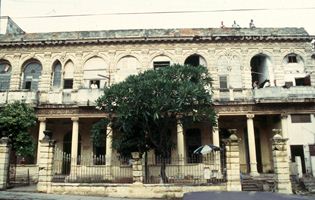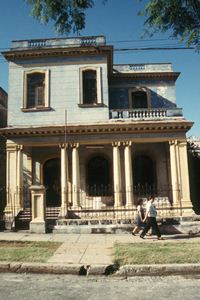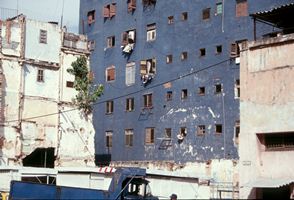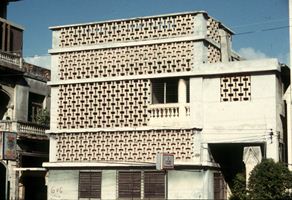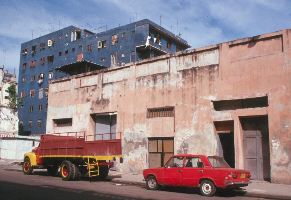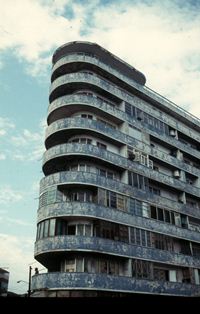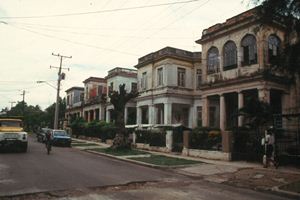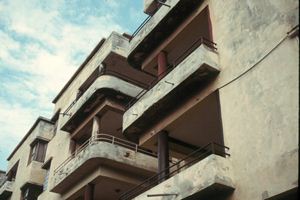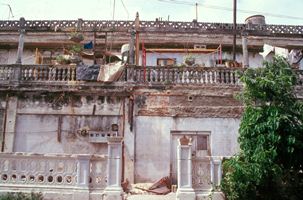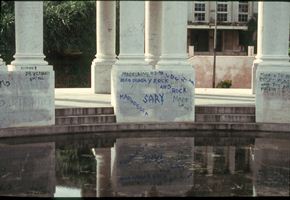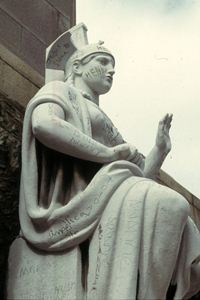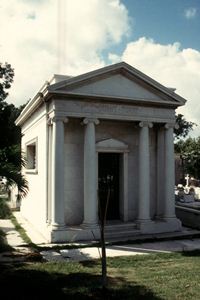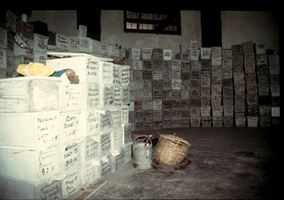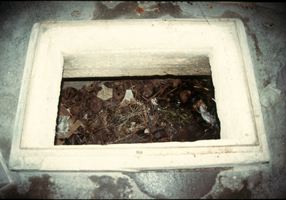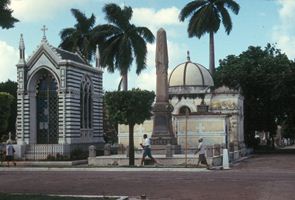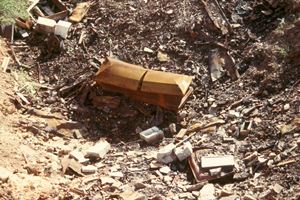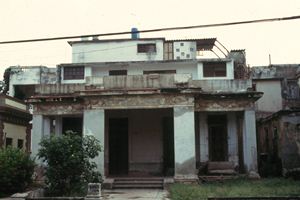Havana IV
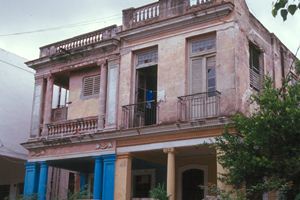
Diary, 25th October 1998:
Yesterday I went for a walk through Vedado, just zigzagging through the grid. Dilapidated buildings, eclectic classical villas crushed by modern or indifferent extensions and repairs like cancerous growths consuming the original fabric. The buildings, usually made of early concrete and brick, are tired: forty years of conscious and politically justified neglect, spiralling out of control by the trade embargo and the collapse of the USSR. To keep the buildings up, some have sandwiched the columns on the first floor verandas between concrete piers. Others have encased the classical columns in concrete jackets. One villa looked as if it had been built of two villas, one eclectic and the other modernist, awkwardly crumpled together. A beautiful Mendelsohnian apartment block rounds a wedge shaped corner of the grid where an errant street, the old road to the quarry, disturbs the rectangular order, thereby curiously reaffirming its inevitable character. The grid accepts the interruption of the errant street and then ignores it completely. It just does what it does. The modernist building has beautiful wrap-around balconies, shooting with great speed around the building, slicing it into firm horizontal slabs. Most of its surface is white but the peeling blue of the balconies dominates. It was the first well-aged modernist building I have seen. On a balcony on the first floor, an old modernist lady was doing her modern exercises, swinging her arms and calling out with great confidence to her friend below on the street.
I walked past the Avenue de los presidentes and went entered the quiet inner realism of the great super-blocks where fading villas hide behind trees lining the streets. The trees have grown too large and are invading the grid, rupturing it, destroying the pavements. A small group of children played with their homemade toys, a scooter on metal wheels. At the top of the Avenue de los presidentes is a large baroque monument embraced by an impressive semi-circular colonnade, all of white marble. The whole thing was covered in graffiti. Mark told me later that when he went there two years ago the smell of urine was overwhelming. When I visited it had just rained generously. I also understood why the fort, which is very present on the map, is not a part of the image of the city; it is set upon high ground. The hill was cut into by the avenue, creating a steep cliff face. Furthermore the fort is now surrounded by a hospital and a lot of greenery, large clumps of slender stems of fig trees cluster together, lashing their aerial roots to the cliff-face. This last was used by sculptors to make stone live on our terms.
When I returned I went to collect Sal from the airport. I got a Private taxi, a nice large Cuban driving a tiny moribund fiat. After we sorted out the hotel room I took him to see the Focsa Building. On top of it there is a restaurant which can be reached by way of a small, very luxuriously appointed lobby, which leads one to a lift taking you straight up to the top without touching the other floors: a vein of resuscitated life within a dead structure. The noise of the wind up there is spectacular. One wonders what it is like to live in the apartments just below. The view is wonderful; the grid divides itself and fades along a simple single-point perspective. From above you can see the infinite subdivision of a city which has not grown outwards for forty years but has divided itself time and time again without demanding more space. Rooms fill up the erstwhile courtyards and the once splendid gardens. Also from up here the city looks tired, exhausted.
The city has veins of renovated fabric running through it which serve the increasing number of tourists. Along these veins people are more aggressive, more aware of your money. Just outside of them, interest in you falls away, or at least becomes less overtly economical.
This morning Mark and I walked up the 23rd Avenue. At the end of it lies a large necropolis, which echoes the city in its use of the grid and its social geometries. Large effusive tombs align the main avenues and smaller ones crowd behind them. Some of the smaller gravestones are interesting in that they have little carved benches to accommodate the grieving, offering participation in grief and death. Heavy stone or marble tombs are often protected by a light metal structure, probably to protect the polish. The effect it has is curious, the permanent being protected by the ephemeral, the monumental preserved by the anti-monumental. Right at the back of the necropolis there is a large octagonal ossuary. Two men were sitting at the entrance. We walked in and found rows and rows of stacked caskets, some made of marble most of concrete, with names written on them. The rows were arranged in concentric circles around the centre of the building, leaving narrow galleries between each stack and a larger central area. Here and there caskets were embellished with plastic flowers, small dolls and sculptures. The man saw our astonishment and motioned us over with a theatrical gesture to a hole in the ground. He lifted the lid and we saw thousands upon thousands of skulls and bones. At the back of the ossuary was a dumping ground for funeral paraphernalia. An old display coffin, dumped and dented, lay at the bottom of it. The necropolis is the exact replica of the city, down to the finest details, a social diagram and organogram of social organisation.
From there we walked towards the sea on our way back. Along one street a man was pushing a cart along balanced on a single large wheel, while playing a haunting and evocative tune on the panpipes to attract attention. He was a knife sharpener and he rolled his sharpening machine like a wheelbarrow. As soon as he had a client he would unfold the wheelbarrow and make the wheel into a flywheel, engage the belt to drive the whole contraption.
Later we went for a drive with a private taxi. Roberto, the taxi driver, wanted to meet us in a quiet street for fear of the police. He then drove us through the extraordinary crumbled wealth of Miramar, past the ridiculous Russian Embassy and the sleek but ruinous Modernism of the outer suburbs of Havana, Siboney and Cubanaca. Havana is a very legible city. From Havana Vieja, where the wealthy occupied the northern part, the newly rich crept along the coast westwards, shedding off intermittent curls of urban development for the poor and the aspiring middle classes inland. These areas form neat gridded islands bound by meandering older roads. The growth of the city, defined by the shoreline, forms a row of curly waves of socially defined neighbourhoods.
